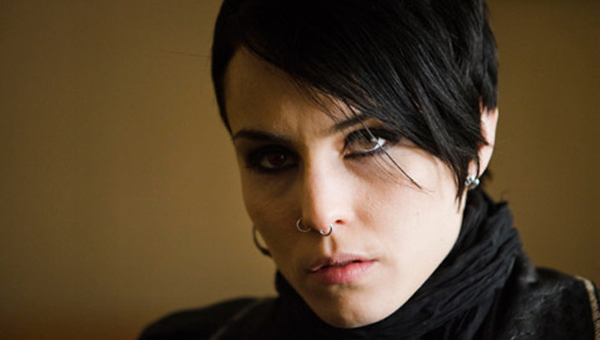The Girl With The Dragon Tattoo Review

I “heart” girls.
Which would appear to place me in the minority of y chromosome endowed characters in The Girl With The Dragon Tattoo.
Or to use the film title in its native tongue, “Men Who Hate Women”.
This is the first big screen adaptation of Swedish author Stieg Larsson’s fiendishly popular Millennium trilogy.
Which I’d never heard of til they released a moving picture version.
Guess this implies I may have been living under one of those oversized rocky things for the past decade.
Still, I’m quite fond of missing the boat on these pop culture fads first time around.
For when I eventually stumble across them everything’s brand new to me.
And as someone who likes surprises, it’s infinitely more interesting to discover something cold; when your mind is free from hype and preconceptions.
The Girl With The Dragon Tattoo opens in a courtroom, where respected journalist Mickael Blomkvist has been sentenced to jail following a successful libel suit filed against him by wealthy industrialist Hans-Erik Wennerströmhe.
In an article for his struggling Millennium magazine, Blomkvist accused Wennerströmhe of using his business as a smokescreen to illegally trade arms.
The ones you’d use to blow up rather than pick up stuff.
Of course, selling either one would be pretty bad.
Anyway, the disgraced Blomkvist’s career hangs in the balance.
Before being sent to jail, he is invited to investigate the mysterious disappearance of Harriet Vanger.
Harriet was the favourite niece of Henrik Vanger; retired President and de facto paterfamilias of the wealthy Vanger dynasty.
Faced with his own mortality towards the end of his life, Henrik’s final wish is to solve the riddle of Harriet’s disappearance some 40 years ago.
Running parallel to Blomkvist’s story is that of Lisbeth Salander, an enigmatic and disenfranchised young woman struggling to break free from the demons of her past.
Salander is a resourceful and modern day researcher, read hacker, who was employed to investigate Blomkvist’s libel suit prior to Henrik approaching him.
Believing him to be the victim of a set up, Salander continues to research Blomkvist even after completing her task.
Until she decodes a vital clue Blomkvist has yet to unravel that may help solve Harriet’s disappearance.
And feels compelled to make contact.
With echoes of modern thrillers like Se7en and Zodiac, I found The Girl With The Dragon Tattoo engrossing viewing.
Michael Nyqvist is quietly convincing as the protagonist Mickael Blomkvist, but it is Noomi Rapace as Lisbeth Salander who really draws the audience into the film.
Rapace takes on some stereotypically masculine characteristics in her portrayal of Salander.
She can be aggressive, cold to emotion and is something of a loner.
But there’s a vulnerability to her too, something Rapace effortlessly conveys in a thoroughly convincing and compelling performance.
Take heed mind, The Girl With The Dragon Tattoo contains disturbing imagery; yet I found these to be neither salacious nor gratuitous.
Each graphically depicted scene serves to move the plot forward or reveal something about a character’s development and motivation.
In fact, there was something almost refreshing about the brutal and honest representations of the darker elements of human nature.
Which tends to be whitewashed from our screens, in keeping with our media’s tradition of sanitising reality.
Given the popularity of Stieg Larsson’s Millennium trilogy, you won’t be surprised to learn Hollywood’s already planning to give The Girl With The Dragon Tattoo a facelift for English speaking audiences.
I’d recommend catching it in its original format though, as the spirit of a story is so often lost in translation in these remakes.
Usually because they’re more interested in translating a film’s commercial success, rather than its heart.
Which is why I’m always keen to hear a story told in its mother tongue, as it helps preserve the voice of the original writer.
And sometimes the way you say something is far more important than what you are saying.
Unless you prefer the crushingly predictable americanised narratives we’ve grown accustomed to.
Or can’t read.
I’d imagine the two go hand in hand.
The only complaint I have, and this has nothing to do with the film really, is that the strong and empowered female character of Lisbeth Salander is still a male representation of these qualities.
Something I’ve become increasingly aware of, as I’ve grown a lot older and a little wiser, is the dominant role of men as either writers or directors in the film industry.
So movies are usually told from a male point of view.
And I’m finding this poverty of female views in our media both boring and disturbing in pretty equal measure.
For all of Salander’s undoubted strength in The Girl With The Dragon Tattoo, it appears to be as a consequence of acts that have occurred in her life.
Blomkvist, on the other hand, is just as strong.
Yet the film offers no reason for this.
Why can’t a female character be innately powerful, without cause, just as male characters are so often portrayed?
Hopefully, Kathryn Bigelow’s Best Director Oscar for The Hurt Locker will be a catalyst for change in the film industry, as well as inspiring a new generation of x chromosome blessed individuals out there.
Because frankly my dear’s, I’m bored of all these male fantasy’s forever being regurgitated in the media.
So girls, rest assured that not all men out there hate women.
I heart all of you.
But please, show us your wits.
Jonathan Campbell